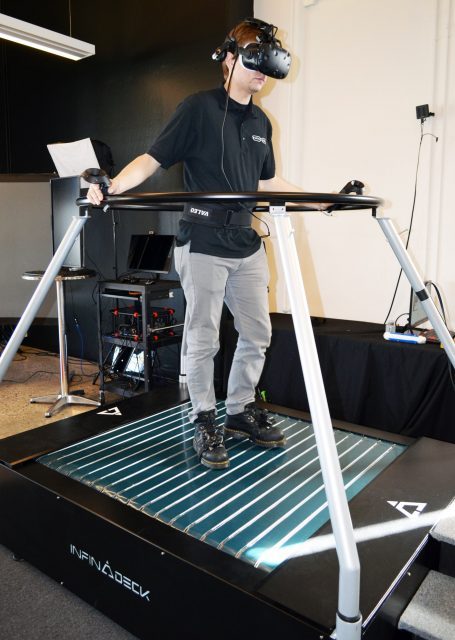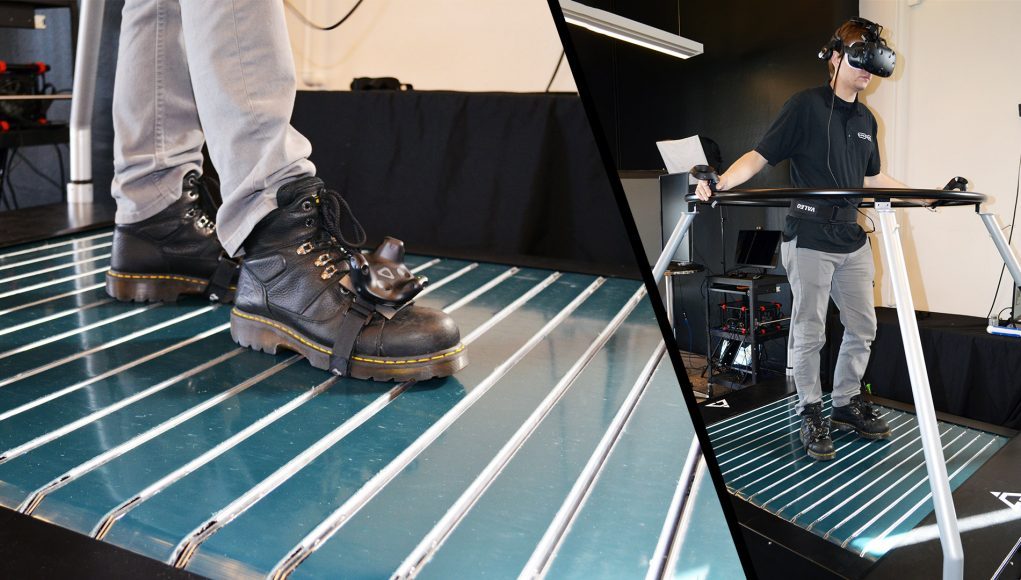Infinadeck is an active omni-directional VR treadmill that lets you walk in any direction. Compared to others, which generally rely on low friction surfaces to emulate the act of walking, Infinadeck’s design actually has a tread that moves beneath you, leading to a much more natural gait. Having stepped on the latest Infinadeck prototype, the VR treadmill is making strides toward a truly compelling solution for artificial locomotion in VR.
I’ve had a chance to try out the Infinadeck at several key milestones during its development, as far back as 2014 when the device made its debut at the very first SVVR Conference & Expo. Even back then, it was clear that the fundamental design—a large ‘tank track’ where each tread itself consists of a mini-treadmill running perpendicular to the direction of the track—had potential. But that 2014 version was manually controlled, with no mechanism at the time to sense the movement of the user and then counteract that movement with opposite vectors from the treadmill.
From that point, the company began investigating tracking mechanisms, and we got our first look in early 2016 where a waist-harness, connected by a pole to a device above, would physically detect the movement of the user, and then use their direction to calculate the counteractive movements. It worked relatively well for walking in straight lines, but the lack of precision and the latency in movement detection made it challenging to walk confidently once you put on the headset and lost some of your proprioception.

With the latest Infinadeck prototype, which I saw recently at SVVR’s Silicon Valley HQ, the company has moved from physical motion detection to using a Vive Tracker mounted on the waist to precisely sense the location of the user with very low latency. Along with Vive Trackers placed on the feet (not currently used for calculating the VR treadmills movements, but used to show the user where their feet are), the feeling of walking has been significantly improved, even when wearing a VR headset.
Thanks to the fact that the surface is physically moving below you, your walking gait is very natural. Especially when heading directly along the ‘track’ direction, or directly along the ‘tread’ direction, it feels almost identical to walking on a normal treadmill. When you are moving diagonally, the movements of both the ‘track’ and the ‘tread’ need to be combined to create a vector of diagonal movement; that can still feel a little bit funky, as if the vector sometimes slightly fluctuates away from the ideal direction. But as with the rest of it, after a few minutes of walking around I began to feel quite comfortable walking in any direction.
Wearing an HTC Vive (made wireless with TPCAST), I strolled around a simple demo scene that worked well enough, though unfortunately they haven’t spent much time precisely matching your actual stride distance to the distance that you move in the virtual world (instead it felt like my virtual movement speed was based on the speed of the treadmill), let alone your height in the experience. So while I could feel the quite natural gait afforded by the treadmill, it’ll take a more polished demo before I can really assess the impact that the system has on immersion.

Other VR treadmills that I’ve tried—like the Virtuix Omni and Cyberith Virtualizer—rely on your feet sliding along low friction surfaces in order to simulate movement. While I’ve found the Omni pretty good for walking and running in a particular direction, turning is where things start to feel especially slippery and unnatural. That’s because walking or running along a curved path is in every way reliant on the friction between your feet and the ground.
Turning on the Infinadeck feels much more natural, since you have the friction of the surface below you to turn yourself as your really would in a normal turning gait. Stopping also benefits a lot from this, and it’s now far more responsive than I’ve seen in previous iterations of the VR treadmill, as the platform gently slides you back to the center and stops you there.
My biggest concern when walking on the Infinadeck, actually, was that I might outpace the treadmill and walk off the edge; indeed I could have if I walked at a brisk pace, but the folks demonstrating the Infinadeck told me they had set the speed significantly lower for demonstrations. They cranked it up a bit for me just to show that it could go faster, but with no safety harness they didn’t want me breaking into a run, let alone a jog.

On this version of the Infinadeck, Instead of a harness, there’s a large ring surrounding you at chest height; inside the headset you can see a virtual representation of the ring as a transparent outline. You aren’t attached to it in any way, but knowing that it’s there (in case you need to lean on it for balance) helps you walk more confidently.
Infinadeck CEO Benjamin Freeman tells me that the support ring is just one of a number of different safety and stability mechanisms that could be used with the VR treadmill. While the hanging harness is no longer necessary for directional input, something similar could still be employed depending upon the use-case. He says that some have been interested in using the Infinadeck for running—something he maintains the treadmill could support—which is a use-case that would likely benefit from the added safety of a hanging harness; physical therapy and rehabilitation too. Of course, running would probably require a larger treadmill, giving the system more time to respond before people get too close to the edge. Freeman says that the present design could accommodate a much larger footprint, including a full room area.
The occasion of my demo with the latest version of the Infinadeck VR treadmill was the company’s beta launch: they’re now accepting applications for their beta testing program, and plan to send early units out to a small number of partners while they continue to tweak the design to fit the needs of clients, which the company expects to be mainly in the enterprise, commercial, military, and other out-of-home sectors. Freeman wasn’t ready to disclose an exact price for the system, but he did say it falls into the ‘greater than $10,000’ category. In addition to the hardware beta testing program, the company is also accepting applications for software developers to get their hands on an early version of their SDK for integration applications with the treadmill.
Following the beta testing period, Freeman maintains wider availability of the Infinadeck is slated to come in 2019.







